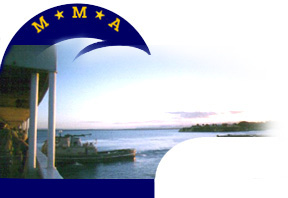
Captain's Log for Tuesday, 08 February 2000
|
As of 0700 Eastern Standard time, 1200 GMT and 1300 ship time, the Empire State was underway from Barcelona, Spain and enroute to Buzzards Bay, Massachusetts. She was located at 36 degrees 29 minutes North Latitude, 002 degrees 54 minutes East Longitude, steering course 257 degrees true at 16 knots. That position places her approximately 190 nautical miles east of Europa Point at Gibraltar. The weather was partly cloudy with winds out of the northwest at 2 knots. Barometric pressure was 1032 millibars of mercury. The air temperature was 62 degrees and the sea water temperature was 58 degrees. The depth of water beneath the keel was 581 meters. CAPTAIN'S LOG The weather and seas were absolutely superb yesterday and we could not afford to waste such fortuitous opportunities. We quickly took advantage of Mother Nature's largesse and completed two Marine Safety and Environmental Protection projects; plankton net towing and expendable bathometer (XBT) deployment. As you remember, we encountered unexpected high winds and bumpy seas enroute to Barcelona. During high wind conditions, the plankton nets act like large sails and want to tack everywhere except into the water. Therefore, we inserted a special "sea weary survival drill" into the agenda that afternoon and rescheduled those important labs for later. Well, it was now "later", so we cleared the Barcelona traffic lanes, slowed down and went to work. Always mindful of supplemental opportunities to excel, we determined that the time was right to train more of the liberty lethargic cadets. When the plankton nets were back aboard, we stopped the ship and exercised the Emergency Boat Crew by launching and recovering the motorlifeboat in the seaway. We conducted this drill at Gibraltar, but doing so at sea adds realism and complexity impossible to duplicate pier side. The open ocean swells cause the lifeboat to swing on the falls like the pendulum of a giant grandfather clock. The increasing pendular action must be controlled until the boat touches the sea and can be released. By then, however, the lifeboat is rising and falling relative to the hull of the huge ship. The 1/C cadet in charge at the scene must manage a maze of lifting wires, ingress ropes and sea painters (long lines that attach the boats to the ship) while releasing the heavy metal hooks and steering the boat away from the hull. The process is tough for seasoned professionals to control but the professionally minded cadets did their usual stellar job. The Deck Watch Team leads the complicated exercise from the Bridge. Even though we are "dead in the water" these cadets must calculate set and drift, practice rapid radar plotting techniques, double check range and bearing information, and initiate emergency communication procedures. Deploying lifeboats is an "all hands" evolution and lessons learned are plentiful. For example, the lifeboat crews have a unique opportunity to see the ship at sea from the perspective of the water surface and invariably they comment, "I should've taken my camera!" With the exception of the anticipated minor problems, things went like clockwork; we recovered all that we deployed, graded the drill excellent and took off. We are making up for the "lost" time now; generating liberty turns for home. Zeus and Poseidon have mercy on us for we sail 'tween the Pillars of Hercules tonight at midnight and onward to the edge of the earth...Just in case the gods are off-line, keep your fingers crossed on the weather. It is mid-winter and the edge of the earth is still the mighty Atlantic. See you tomorrow, heading due west. QUESTIONS FOR WEDNESDAY 09 FEBRUARY 2000 GEOGRAPHY: The cadets thoroughly enjoyed their visit last month to the island of Madeira, which is a Portuguese territory. Which country was known as Portuguese West Africa? SCIENCE: When the Empire State sails into Cape Cod Bay they will be in the middle of the feeding grounds of the endangered Right whale. What does the Right whale feed on during its stay in Cape Cod Bay? HISTORY: Cadets that attend the Massachusetts Maritime Academy learn navigation, astronomy, and cartography. In what year was the first school to teach these courses established and by whom? MATH: The Cadet Chief Mate is planning a beach party and wants to construct several canopies to protect against sunburn. He calculated that he needs 28 pieces of rope to the job and each piece must be 12 feet long. He sent Cadet 4/C Shapier to buy the line. The line is packaged in 80-foot lengths. How many packages of rope does he need to buy? ANSWERS FOR TUESDAY 08 FEBRUARY 2000 GEOGRAPHY: Alaska SCIENCE: It is not known exactly how whales sing. However, it is known that air is circulated around channel like nasal passages, and whales seem to constrict those passages to create the songs. HISTORY: The Chinese in the 1st Century A.D. MATH: 7754 cubic feet.
|
|
||||||||||||||||||||||||||||||||||||||||||||||||||